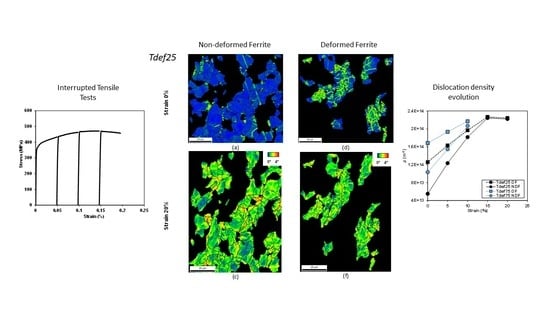Analysis of Strain Partitioning in Intercritically Deformed Microstructures via Interrupted Tensile Tests
Abstract
1. Introduction
2. Materials and Methods
2.1. EBSD-Based Characterization Procedure
2.2. Nanoindentation Test
2.3. Interrupted Tensile Tests
3. Results and Discussion
3.1. Initial Microstructures
3.2. Nanoindentation Study
3.3. Mechanical Behavior during the Interrupted Tensile Test
3.4. Microstructural Evolution during Tensile Testing
3.5. Evolution of the Microstructure in Individual Ferrite Populations (NDF and DF)
3.6. Quantification of Microstructural Features
3.7. Relation between Dislocation Density, Nanohardness and Strain Partitioning
4. Conclusions
Author Contributions
Funding
Institutional Review Board Statement
Informed Consent Statement
Data Availability Statement
Acknowledgments
Conflicts of Interest
References
- Gohda, S.; Watanabe, K.; Hashimoto, Y. Effects of the intercritical rolling on structure and properties of low carbon steel. ISIJ Int. 1981, 21, 6–15. [Google Scholar] [CrossRef]
- Speich, G.R.; Dabkowski, D.S. Effect of deformation in the austenite and austenite-ferrite regions on the strength and fracture behaviour of C, C-Mn-Cb and C-Mn-Mo-Cb steels. In The Hot Deformation of Austenite Conference; Ballance, J.B., Ed.; AIME: New York, NY, USA, 1979; pp. 557–597. [Google Scholar]
- Phillips, R.; Chapman, J.A. Influence of finish rolling temperature on mechanical properties of some commercial steels rolled to 13/16 in. diameter bars. J. Iron Steel Inst. 1966, 204, 615–622. [Google Scholar]
- Abbas, M.; Ismail, A.; Ghazaly, S.; Bitar, T. Intercritical deformation of low carbon steels. Can. Metall. Q. 2004, 43, 109–116. [Google Scholar] [CrossRef]
- Chabbi, L.; Lehnert, W. Microstructural formation, deformation behavior and deformability of heat treatment steels in the two-phase region. Rev. Met. Paris 2000, 97, 589–598. [Google Scholar] [CrossRef]
- Mayo, U.; Isasti, N.; Jorge, B.D.; Rodriguez, I.J.M.; Uranga, P. An EBSD-based methodology for the characterization of intercritically deformed low carbon steel. Mater. Charact. 2019, 147, 31–42. [Google Scholar] [CrossRef]
- Mayo, U.; Isasti, N.; Rodriguez, I.J.M.; Uranga, P. Interaction between Microalloying Additions and Phase Transformation during Intercritical Deformation in Low Carbon Steels. Metals 2019, 9, 1049. [Google Scholar] [CrossRef]
- Mayo, U.; Isasti, N.; Rodriguez, I.J.M.; Uranga, P. On the characterization procedure to quantify the contribution of microstructure on mechanical properties in intercritically deformed low carbon HSLA steels. Mater. Sci. Eng. A 2020, 792. [Google Scholar] [CrossRef]
- Furnemont, Q.; Kempf, M.; Jacques, J.; Goken, M.; Delannay, F. On the measurement of the nanohardness of the constitutive phases of TRIP-assisted multiphase steels. Mater. Sci. Eng. A 2002, 328, 26–32. [Google Scholar] [CrossRef]
- Rodriguez, R.; Gutierrez, I. Correlation between nanoindentation and tensile properties: Influence of the indentation size effect. Mater. Sci. Eng. A 2003, 361, 377–384. [Google Scholar] [CrossRef]
- He, B.B.; Zhu, K.; Huang, M.X. On the nanoindentation behaviour of complex ferritic phases. Philos. Mag. Lett. 2014, 94, 439–446. [Google Scholar] [CrossRef]
- Choi, B.W.; Seo, D.H.; Jang, J.I. A nanoindentation study on the micromechanical characteristics of API X100 pipeline steel. Met. Mater. Int. 2009, 15, 373–378. [Google Scholar] [CrossRef]
- Taboada, M.C.; Elizalde, M.R.; Jorge, B.D. Austempering in low-C steels: Microstructure development and nanohardness characterization. J. Mater. Sci. 2019, 54, 5044–5060. [Google Scholar] [CrossRef]
- Ghasemi, B.S.S.; Fereiduni, E. Effect of prior austenite carbon partitioning on martensite hardening variation in a low alloy ferrite–martensite dual phase steel. Mater. Sci. Eng. A 2014, 619, 129–136. [Google Scholar] [CrossRef]
- Mazaheri, Y.; Kermanpur, A.; Najafizadeh, A. Nanoindentation study of ferrite-martensite dual phase steels developed by a new thermomechanical processing. Mater. Sci. Eng. A 2015, 639, 8–14. [Google Scholar] [CrossRef]
- Li, H.; Gao, S.; Tian, Y.; Terada, D.; Shibata, A.; Tsuji, N. Influence of tempering on mechanical properties of ferrite and martensite dual phase steel. Mater. Today Proc. 2015, 2, 667–671. [Google Scholar] [CrossRef]
- He, B.B.; Huang, M.X.; Liang, Z.Y.; Ngan, A.H.W.; Luo, H.W.; Shi, J.; Cao, W.Q.; Dong, H. Nanoindentation investigation on the mechanical stability of individual austenite grains in a medium-Mn transformation-induced plasticity steel. Scr. Mater. 2013, 69, 215–218. [Google Scholar] [CrossRef]
- Hossain, R.; Pahlevani, F.; Quadir, M.Z.; Sahajwalla, V. Stability of retained austenite in high carbon steel under compressive stress: An investigation from macro to nano scale. Sci. Rep. 2016, 6, 1–11. [Google Scholar] [CrossRef]
- Yvell, K.; Grehk, T.M.; Hedström, P.; Borgenst, A.; Engberg, G. EBSD analysis of surface and bulk microstructure evolution during interrupted tensile testing of a Fe-19Cr-12Ni alloy. Mater. Charact. 2018, 141, 8–18. [Google Scholar] [CrossRef]
- Askari, P.M.; Shahverdi, H.R.; Miresmaeili, R.; Beladi, H. Analysis of tensile deformation behavior of AM2B® advanced high-strength steel using electron back-scattered diffraction technique. Mater. Charact. 2017, 130, 64–73. [Google Scholar] [CrossRef]
- Wright, S.I.; Suzuki, S.; Nowell, M.M. In situ EBSD observations of the evolution in crystallographic orientation with deformation. JOM 2016, 68, 2730–2736. [Google Scholar] [CrossRef]
- Saeidi, N.; Ashrafizadeh, F.; Niroumand, B.; Barlat, F. EBSD study of micromechanisms involved in high deformation ability of DP steels. Mater. Des. 2015, 87, 130–137. [Google Scholar] [CrossRef]
- Tan, X.; Ponge, D.; Lu, W.; Xu, Y.; Yang, X.; Rao, X.; Wu, D.; Raabe, D. Carbon and strain partitioning in a quenched and partitioned steel containing ferrite. Acta Mater. 2019, 165, 561–576. [Google Scholar] [CrossRef]
- Uranga, P.; Gutierrez, I.; Lopez, B. Determination of recrystallization kinetics from plane strain compression tests. Mater. Sci. Eng. A 2013, 578, 174–180. [Google Scholar] [CrossRef]
- Oliver, W.C.; Pharr, G.M. An improved technique for determining hardness and elastic modulus using load and displacement sensing indentation experiments. J. Mater. Res. 1992, 7, 1561–1583. [Google Scholar] [CrossRef]
- Mayo, U. Impact of intercritical deformation on microstructural evolution and mechanical properties in low carbon steels. Ph.D. Thesis, University of Navarra, San Sebastian, Spain, 2019. [Google Scholar]
- Calcagnotto, M.; Ponge, D.; Demir, E.; Raabe, D. Effect of grain refinement to 1μm on strength and toughness of dual-phase steels. Mater. Sci. Eng. A 2010, 257, 7832–7840. [Google Scholar] [CrossRef]
- Kubin, L.P.; Mortensen, A. Geometrically necessary dislocations and strain-gradient plasticity: A few critical issues. Scr. Mater. 2003, 48, 119–125. [Google Scholar] [CrossRef]
- Saito, Y. Mathematical model of hot deformation resistance in austenite-ferrite two phase region. ISIJ Int. 1987, 27, 419–424. [Google Scholar] [CrossRef]
- Luo, H.; Sietsma, J.; Zwaag, S. A novel observation of strain-induced ferrite to austenite retransformation after intercritical deformation of C-Mn steel. Metall. Mater. Trans. A 2004, 35, 2789–2797. [Google Scholar] [CrossRef]
- Mohamadizadeh, A.; Zarei, H.A.; Mehtonen, S. Correlation of strain accommodation factor with the state of microstructural components in a multiphase steel. ISIJ Int. 2015, 55, 2406–2415. [Google Scholar] [CrossRef]
- Sakai, T.; Ohashi, M. Static restoration after hot deformation of a 2.9% Si steel. ISIJ Int. 1984, 70, 2160–2167. [Google Scholar]
- Bodin, A. Intercritical Deformation of Low-Alloy Steels; Delft University of Technology: Delft, The Netherlands, 2002. [Google Scholar]
- Tomota, Y.; Minoru, U.; Nozomi, K.; Akifumi, H.; Norihiro, N.; Akio, M.; Tsutomu, W.; Shigenobu, N.; Goro, A.; Kazutoshi, K.; et al. Prediction of mechanical properties of multi-phase steels based on stress-strain curves. ISIJ Int. 1992, 32, 343–349. [Google Scholar] [CrossRef]
- Ashrafizadeh, N.F.; Niroumand, B.; Forouzan, M.R.; Barlat, F. Damage mechanism and modeling of void nucleation process in a ferrite–martensite dual phase steel. Eng. Frac. Mech. 2014, 127, 97–103. [Google Scholar] [CrossRef]
- Scott, C.P.; Shalchi, A.B.; Pushkareva, I.; Fazeli, F.; Allain, S.Y.P.; Azizi, H. New insights into martensite strength and the damage behaviour of dual phase steels. Acta Mater. 2018, 159, 112–122. [Google Scholar] [CrossRef]
- Choi, S.H.; Kim, E.Y.; Kim, S.I. The micromechanical deformation behaviors of hot-rolled 590FB steel during hole-expansion test. Int. J. Plast. 2014, 58, 184–200. [Google Scholar] [CrossRef]
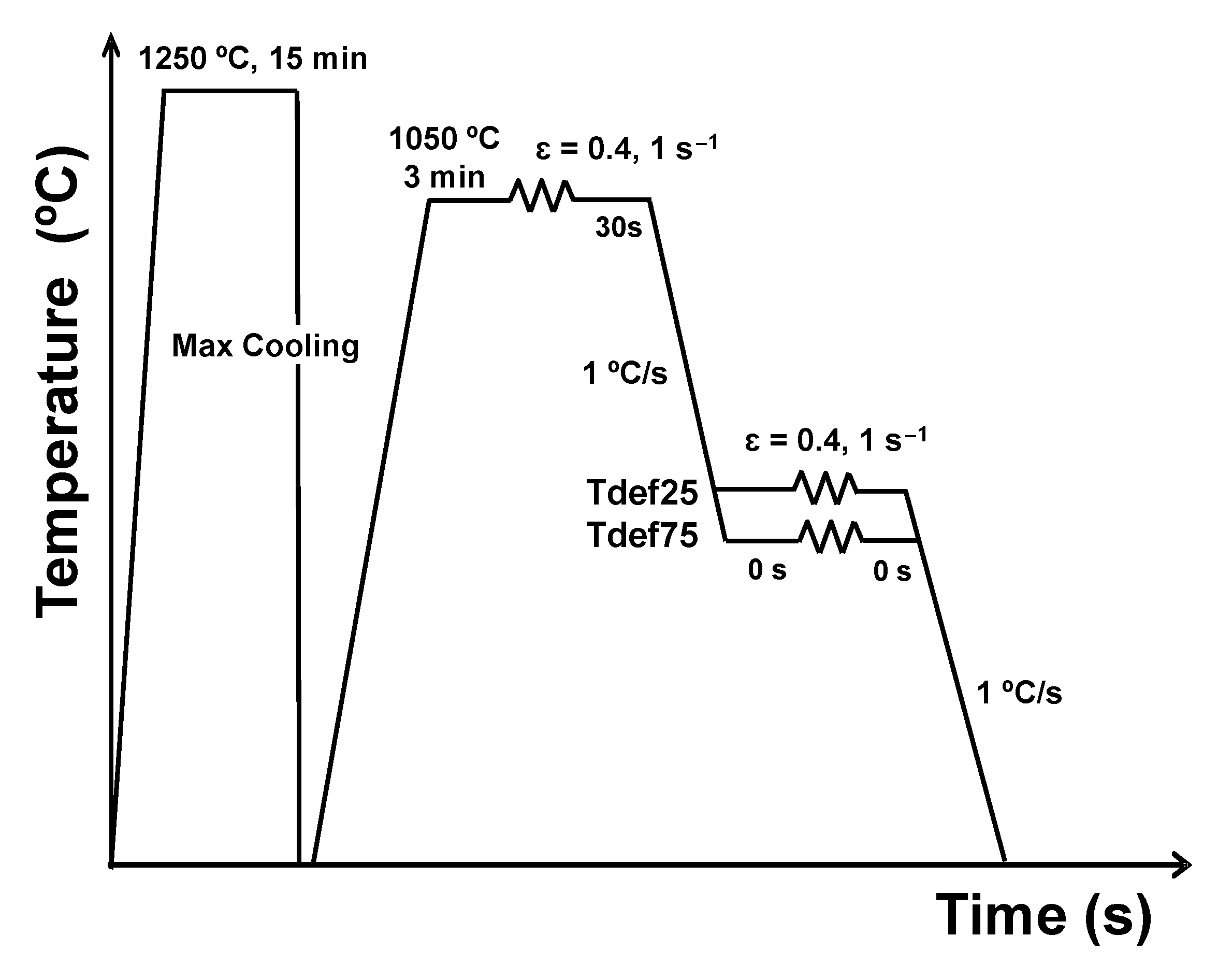

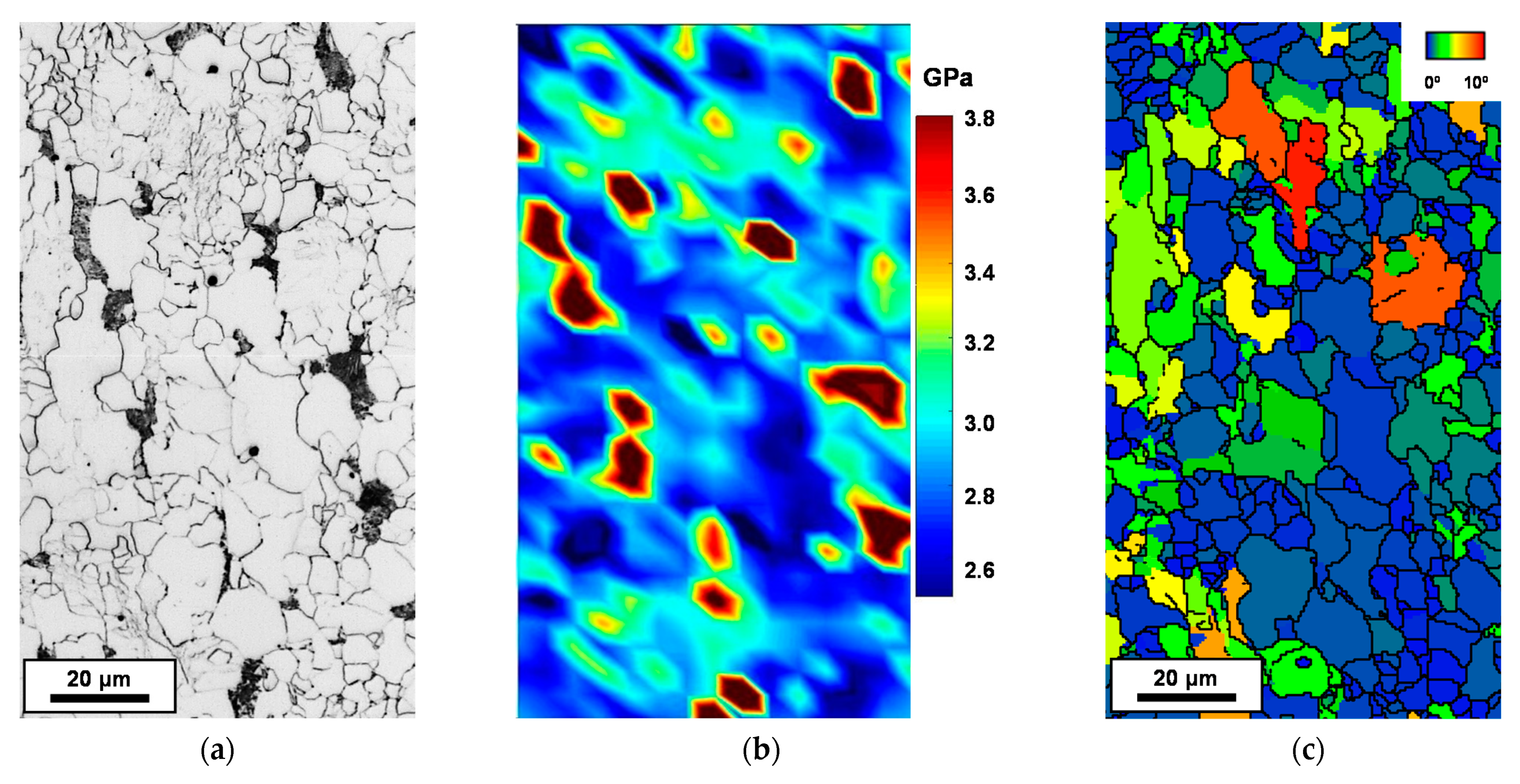

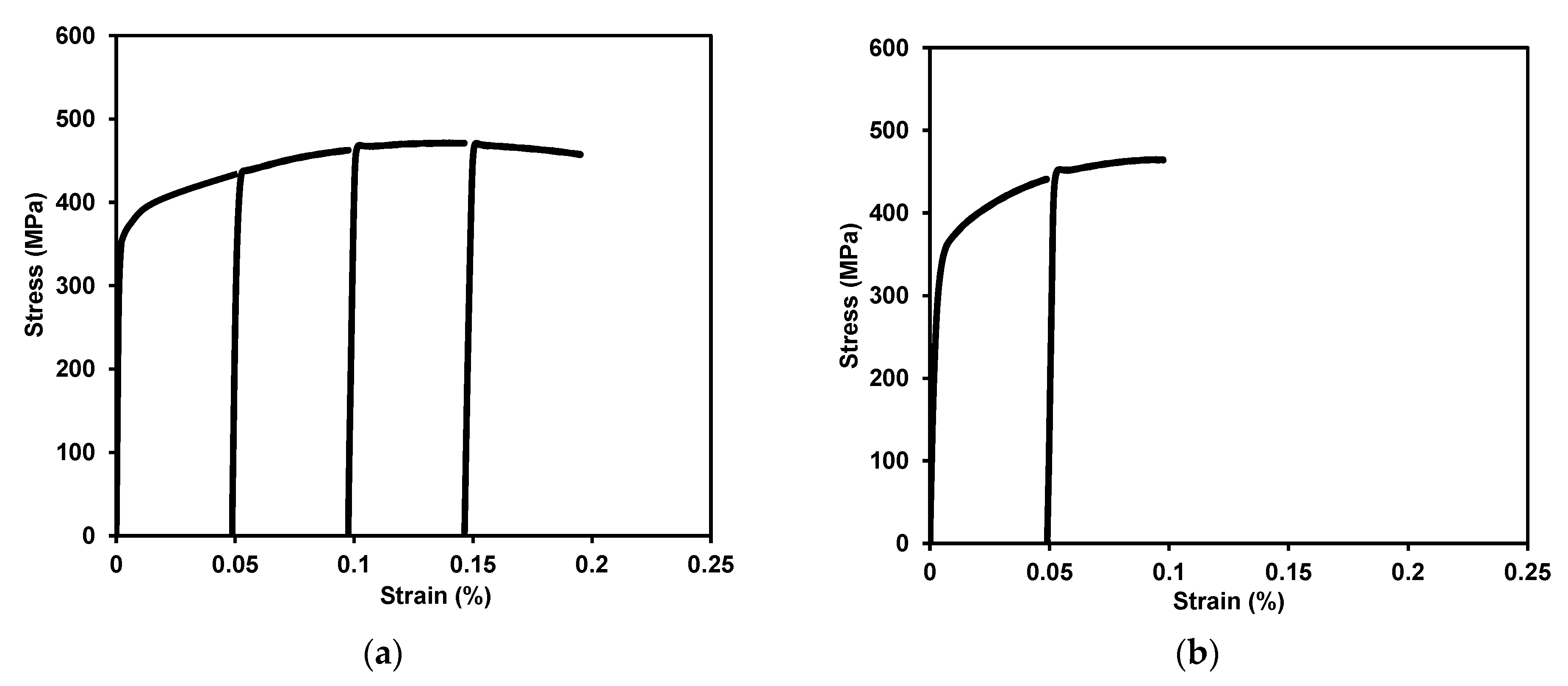

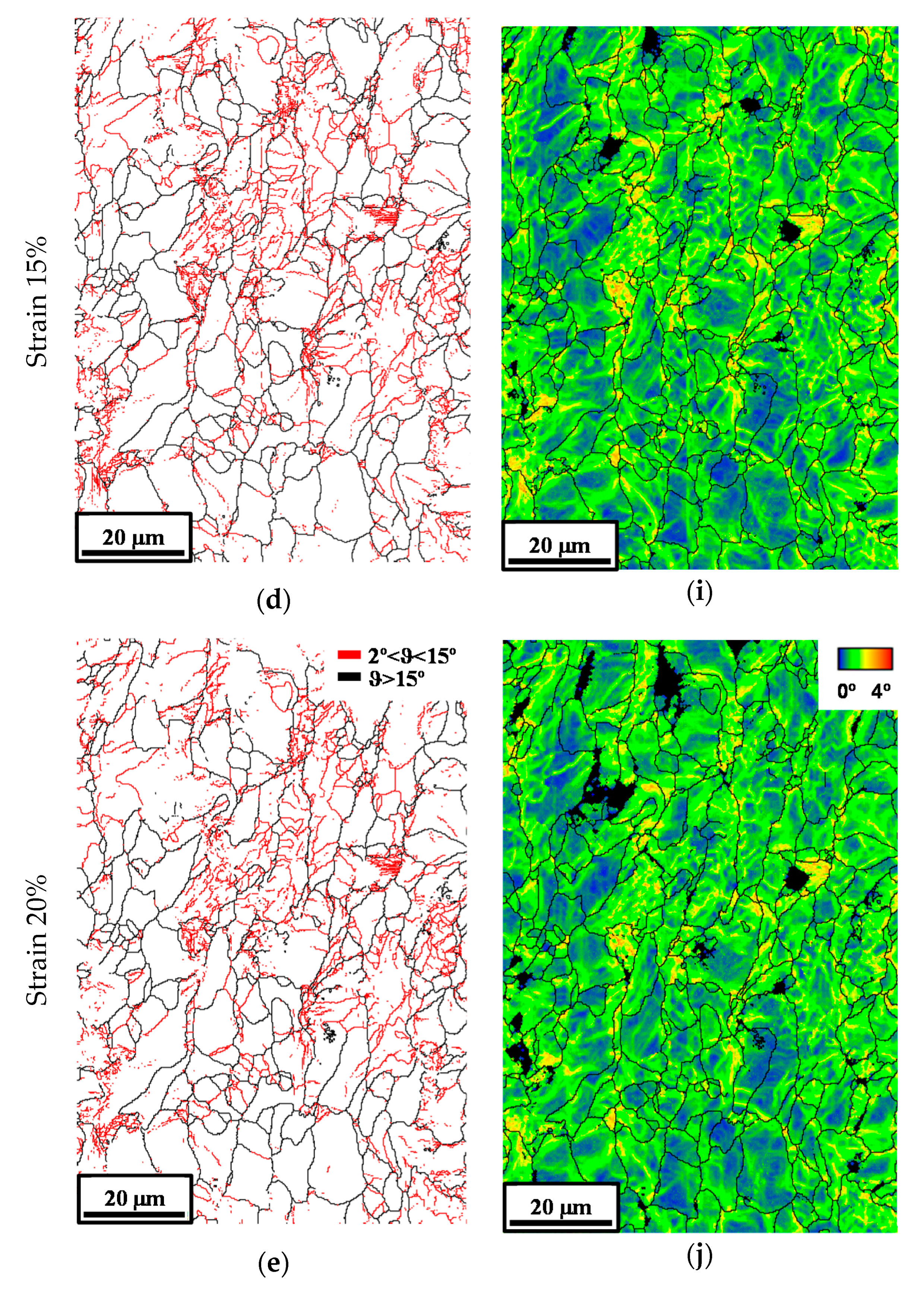
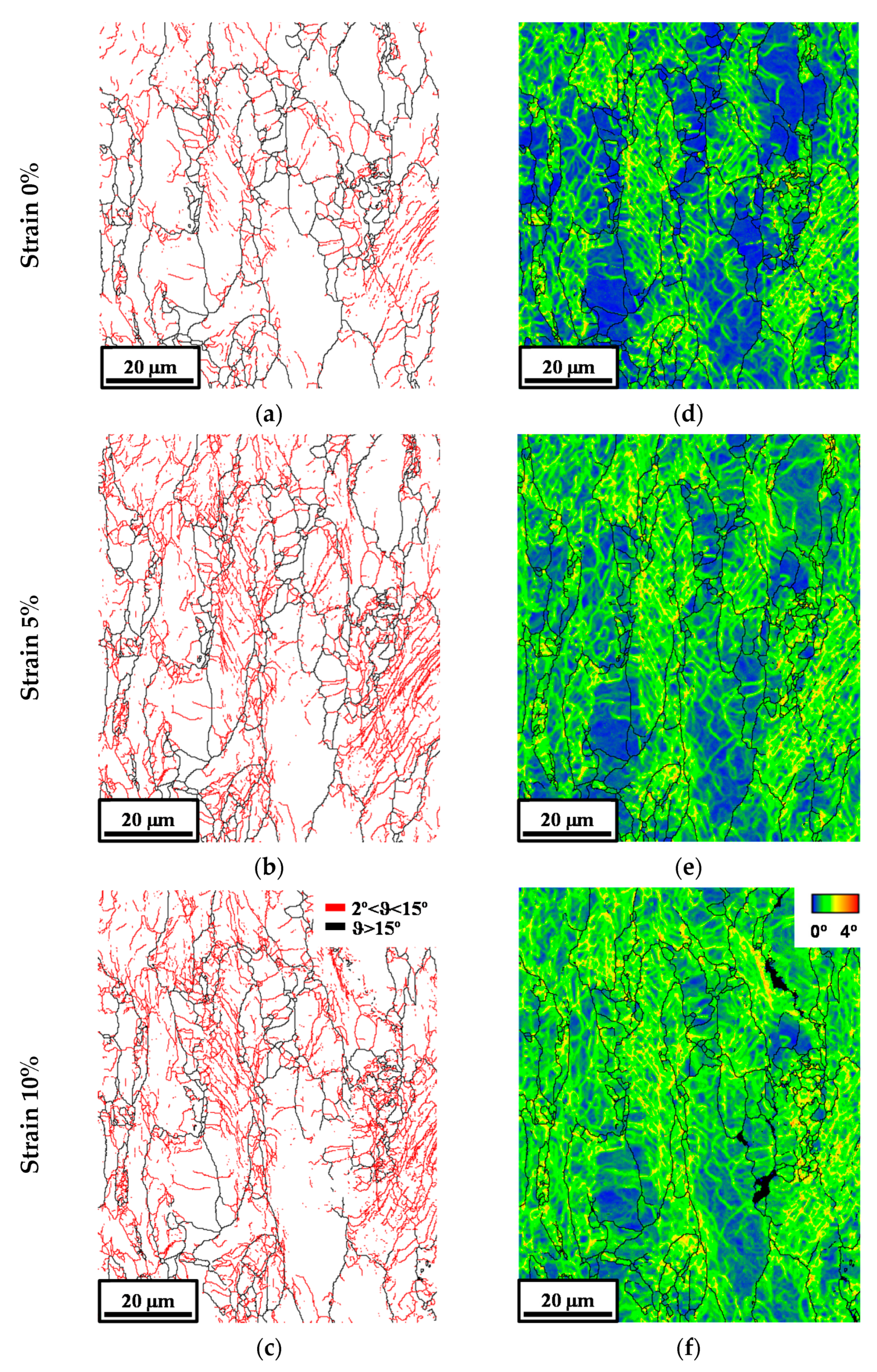
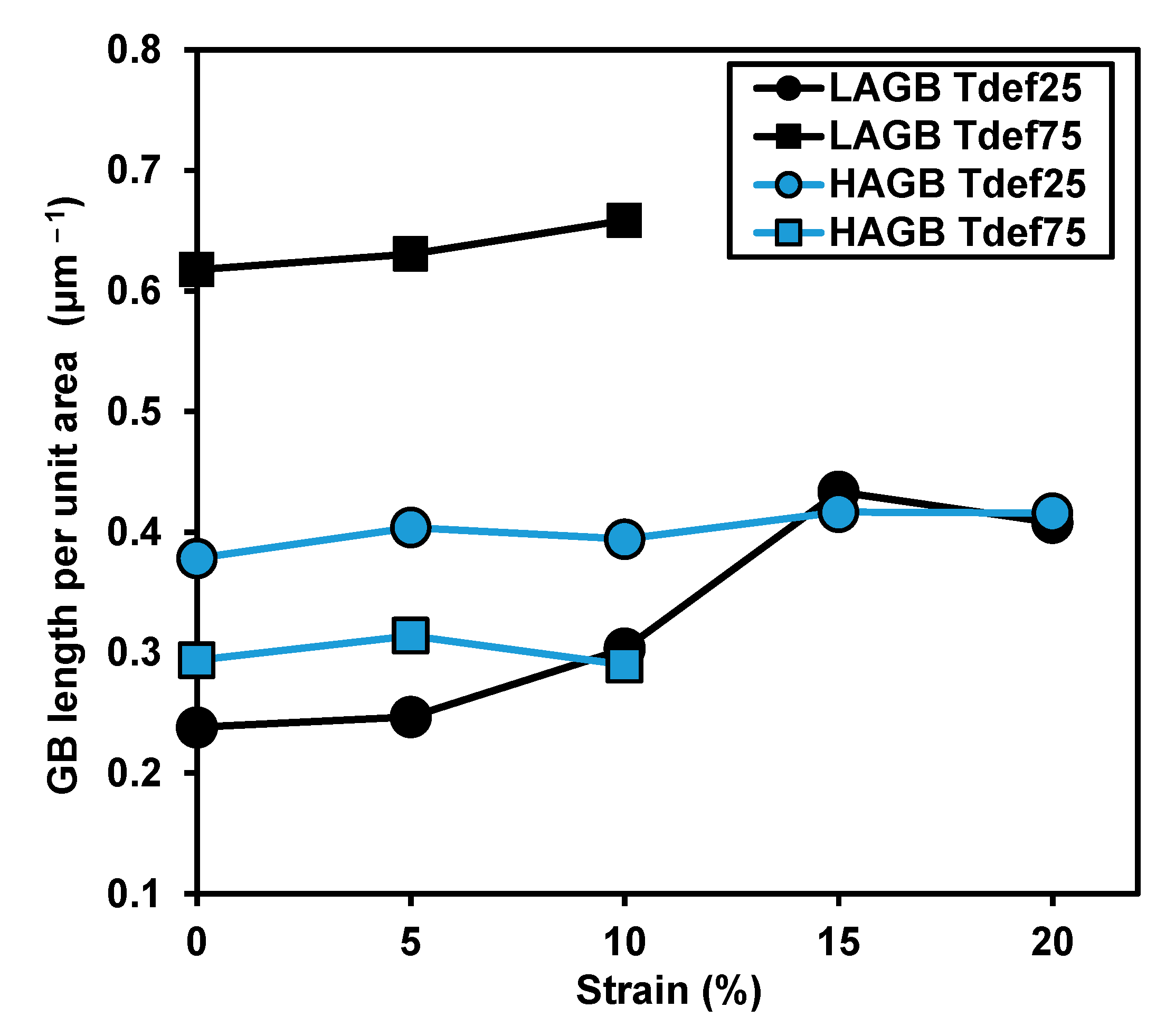
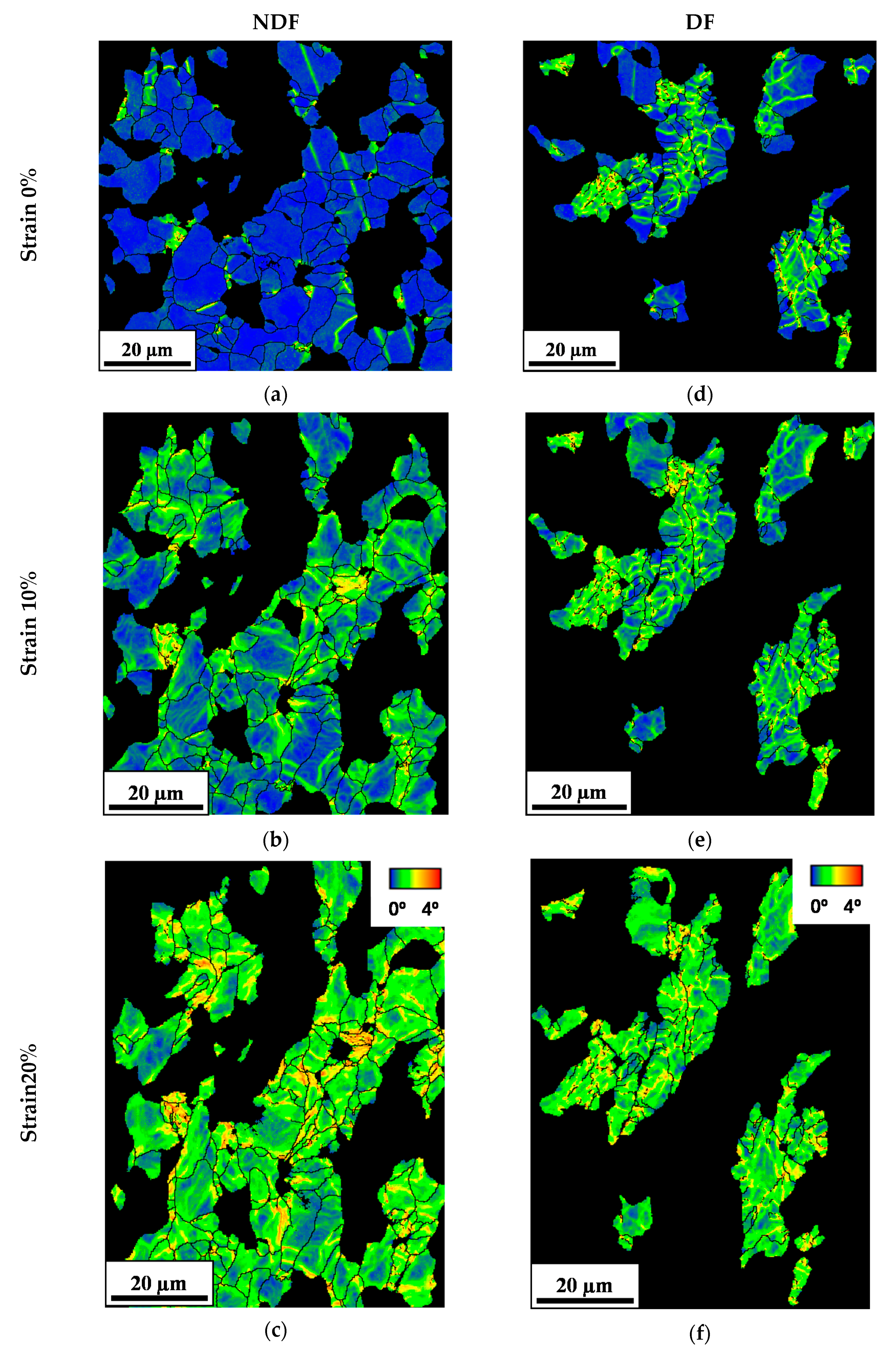
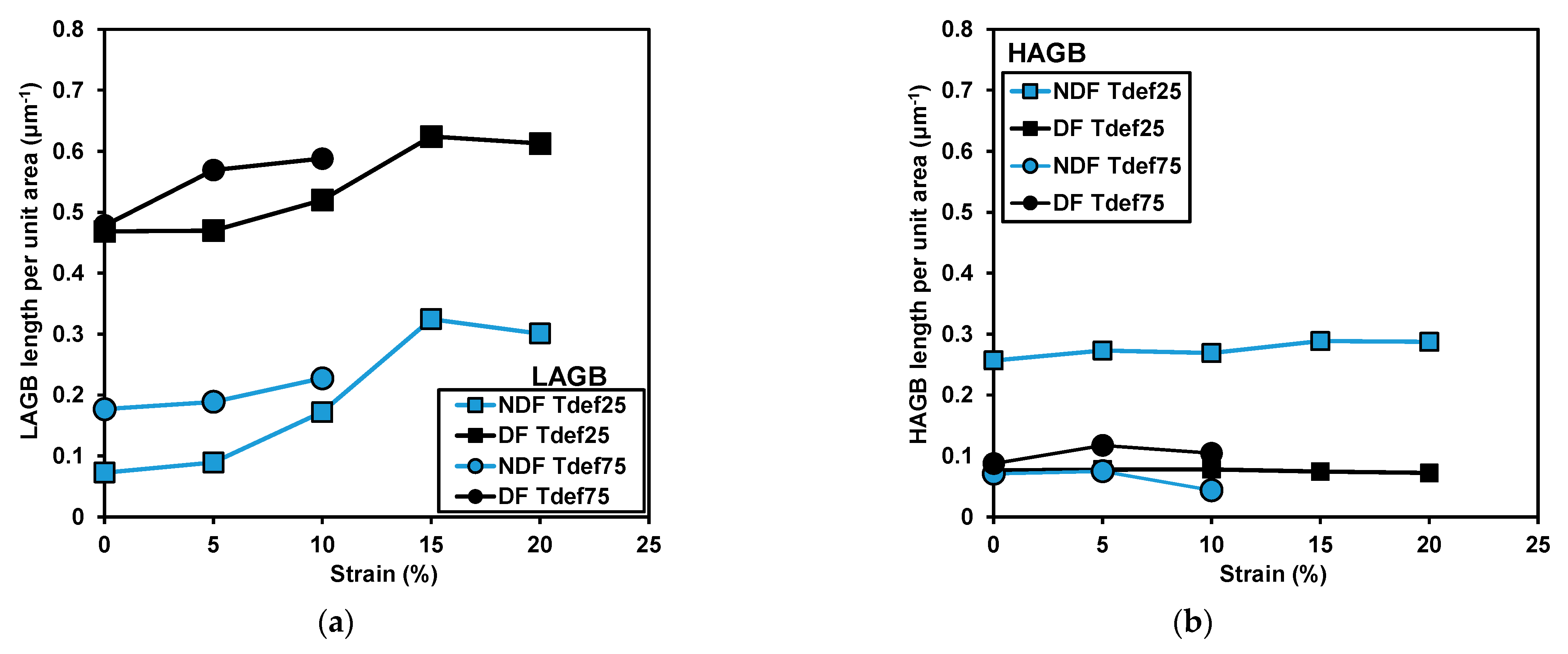
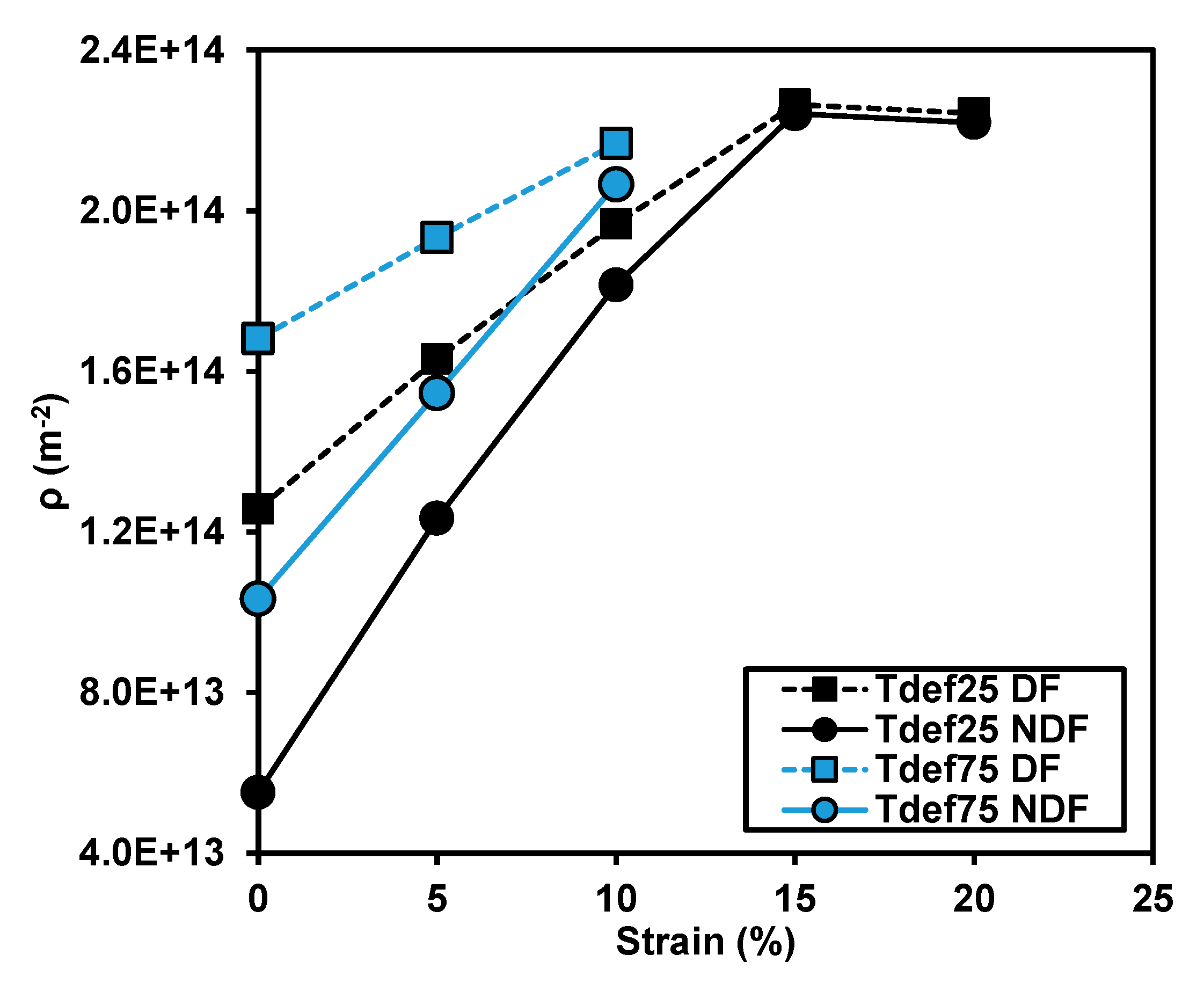
| Steel | C | Mn | Si | Cr | V | Ti | Al | Nb | N |
|---|---|---|---|---|---|---|---|---|---|
| NbV | 0.062 | 1.52 | 0.25 | 0.012 | 0.034 | 0.002 | 0.038 | 0.056 | 0.004 |
| Deformation Temperature | Strain Condition | Scan Area (μm2) | LAGB Density (μm−1) | HAGB Density (μm−1) | KAM (°) |
|---|---|---|---|---|---|
| Tdef25 | 0% | 90 × 90 | 0.23 | 0.38 | 0.3 |
| 5% | 92 × 86 | 0.25 | 0.4 | 0.6 | |
| 10% | 100 × 85 | 0.30 | 0.39 | 0.9 | |
| 15% | 106 × 84 | 0.43 | 0.42 | 1.1 | |
| 20% | 110 × 80 | 0.4 | 0.42 | 1.1 | |
| Tdef75 | 0% | 90 × 90 | 0.61 | 0.29 | 0.8 |
| 5% | 92 × 86 | 0.63 | 0.31 | 0.9 | |
| 10% | 100 × 85 | 0.66 | 0.29 | 1.1 |
Publisher’s Note: MDPI stays neutral with regard to jurisdictional claims in published maps and institutional affiliations. |
© 2021 by the authors. Licensee MDPI, Basel, Switzerland. This article is an open access article distributed under the terms and conditions of the Creative Commons Attribution (CC BY) license (http://creativecommons.org/licenses/by/4.0/).
Share and Cite
Mayo, U.; Isasti, N.; Rodríguez-Ibabe, J.M.; Uranga, P. Analysis of Strain Partitioning in Intercritically Deformed Microstructures via Interrupted Tensile Tests. Metals 2021, 11, 112. https://doi.org/10.3390/met11010112
Mayo U, Isasti N, Rodríguez-Ibabe JM, Uranga P. Analysis of Strain Partitioning in Intercritically Deformed Microstructures via Interrupted Tensile Tests. Metals. 2021; 11(1):112. https://doi.org/10.3390/met11010112
Chicago/Turabian StyleMayo, Unai, Nerea Isasti, José M. Rodríguez-Ibabe, and Pello Uranga. 2021. "Analysis of Strain Partitioning in Intercritically Deformed Microstructures via Interrupted Tensile Tests" Metals 11, no. 1: 112. https://doi.org/10.3390/met11010112
APA StyleMayo, U., Isasti, N., Rodríguez-Ibabe, J. M., & Uranga, P. (2021). Analysis of Strain Partitioning in Intercritically Deformed Microstructures via Interrupted Tensile Tests. Metals, 11(1), 112. https://doi.org/10.3390/met11010112






